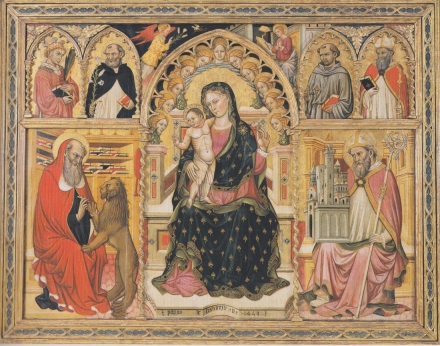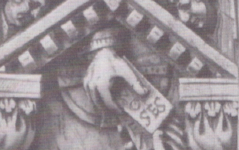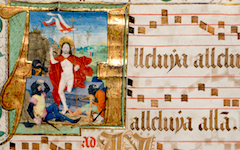Lianori’s Bologna Polyptych (1453)
This polyptych dated 1453 by a little-known master from Bologna is a good example of how artists, even before the High Renaissance, created images on the hidden theme of creation. Exoteric viewers always consider the subject something else entirely.
The exoteric theme is the glorification of the Madonna and Child (center) accompanied by the patron saint of the church for which it was painted, St.Jerome (left), and of the city itself, St. Petronius (right). Above them are four of the most venerated saints and a scene of The Annunciation across the arch. This, though, is what esoteric viewers see:
Click next thumbnail to continue
The theme of The Annunciation taking place over an arch, as it does here, with the Angel Gabriel on one side and the dove of the Holy Spirit flying to impregnate the Virgin on the other, is a common sight over the doorways to Gothic churches. As the faithful passed through the outer arch, from the light of day to the dark interior, they were entering a copy here on earth of the divine womb itself, the original source of Creation.1 Thus in the similarly mandorla- or womb-shaped arch to this altarpiece is illustrated the very product of that Immaculate Conception, the Christ Child.
Click next thumbnail to continue
In the left panel is the traditional scene of St. Jerome plucking a thorn from the paw of the lion but, as so often in art, St. Jerome uses his tool as though he was an artist painting the lion with the blood as paint. Once again, given that the lion is the saint's attribute, the saint is painting himself.
Click next thumbnail to continue
On the other side, St. Petronius, the patron saint of Bologna, holds a model of the city as though he was the architect. The symbol of the artist-architect is significant in that architects had few, if no, written plans and had to hold a detailed model of their building in their minds. God himself was called the Great Architect. Since all kinds of esoteric knowledge remained alive amongst craftsmen in the Middle Ages, a remark by Plotinus (c.204 – 270) may be pertinent.2 The great Neoplatonist whose philosophy had a major influence on early Christians noted that an architect pronounces a building beautiful only in so far as it matches the pattern of his own soul.3 In other words, an architect builds himself.
Click next thumbnail to continue
As if to confirm that all three of these Creation-based scenes take place in the mind of the painter himself, Pietro placed the sign of his authorship where there could be no doubt. Under the Virgin’s throne in the very center of the altarpiece he wrote “petrus de lianoris p 1453” with the ‘p’ for painted (or pinxit). Note that the two most significant signs, his last name and the ‘p’, are emphasized in the curve below the Virgin’s womb. The artist, however little we know of him, was in the middle of the fifteenth century painting himself.
More Works by Medieval (Miscellaneous)
Notes:
1. Msgr. Timothy Verdon, Mary in Florentine Art (Florence: Mandragora/Memoriae Ecclesiae) 2003, pp. 24-26
2. See this remarkable book, especially Chapter Four, on the knowledge of craftsmen in the Middle Ages: Pamela H. Smith, The Body of the Artisan: Art and Experience in the Scientific Revolution (University of Chicago Press) 2004
3. Kathleen Raine, The Inner Journey of the Poet (New York: George Braziller) 1982, p. 17
Original Publication Date on EPPH: 13 Sep 2010. | Updated: 0. © Simon Abrahams. Articles on this site are the copyright of Simon Abrahams. To use copyrighted material in print or other media for purposes beyond 'fair use', you must obtain permission from the copyright owner. Websites may link to this page without permission (please do) but may not reproduce the material on their own site without crediting Simon Abrahams and EPPH.








